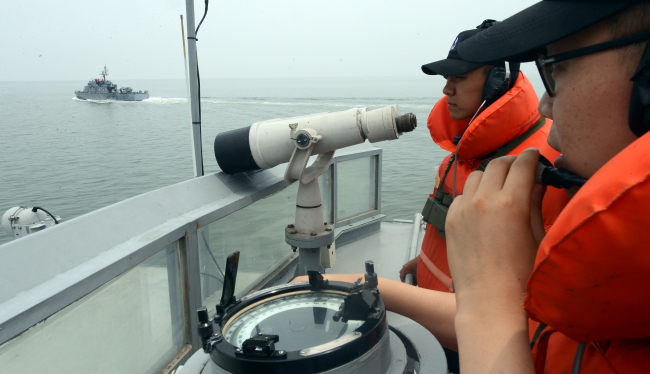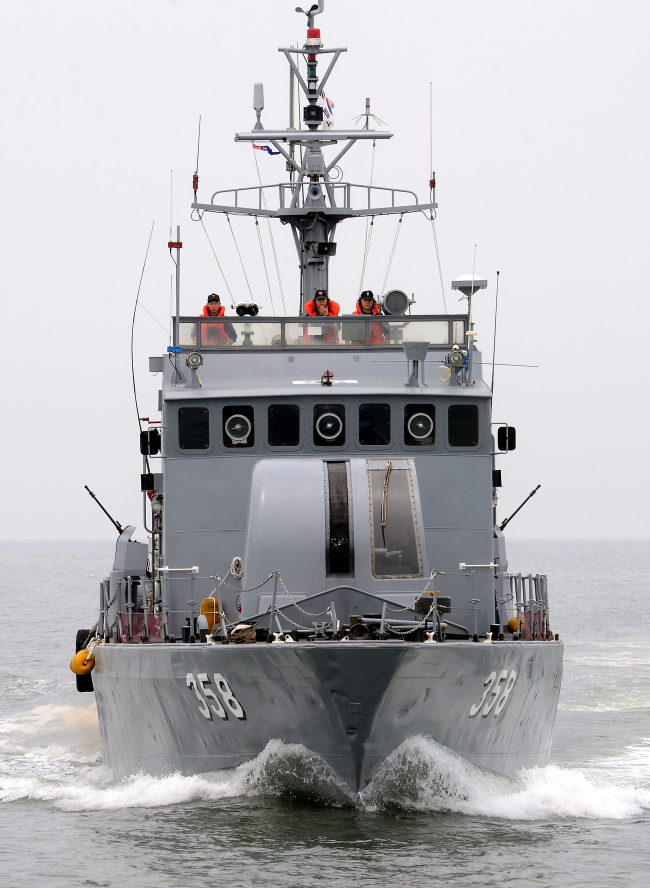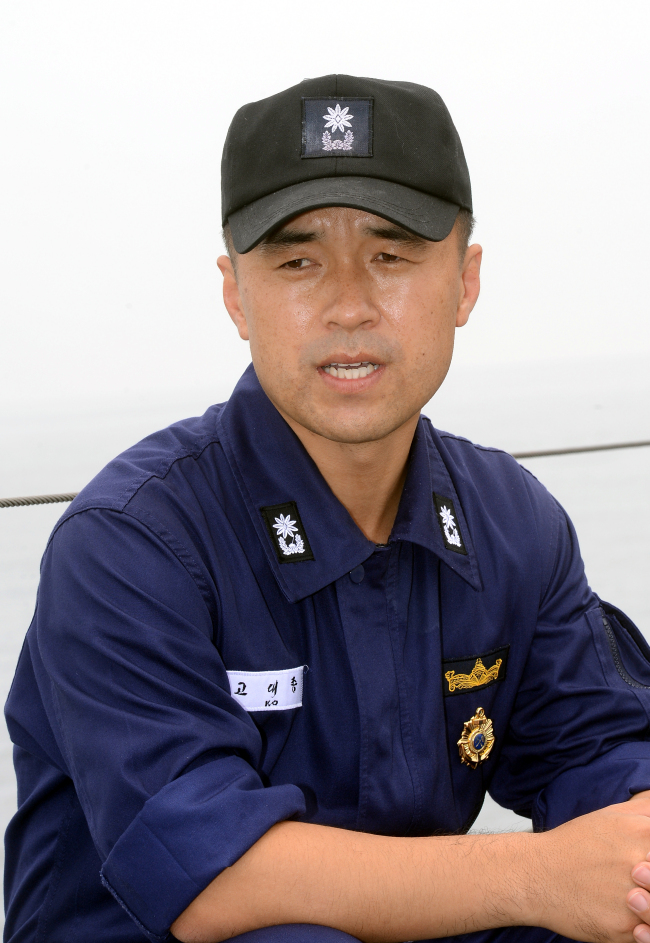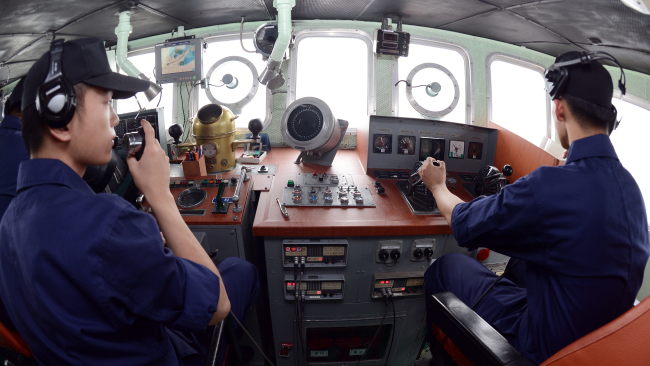
This is the third in a series of articles to mark the 60th anniversary of the armistice agreement that ended the 1950-53 Korean War. ― Ed.
YEONPYEONGDO ISLAND ― For politicians, the Northern Limit Line may be a useful fodder to help swing the political pendulum in their favor. But for the frontline Navy, the de facto maritime border is the very reason for its existence.
“It is an extension of our territory that we must safeguard and for which our comrades have made ultimate sacrifices ― why we are doing our utmost to protect it at all costs,” Lt. Cmdr. Ko Dae-jong told The Korea Herald on the Chamsuri-361 patrol ship.
YEONPYEONGDO ISLAND ― For politicians, the Northern Limit Line may be a useful fodder to help swing the political pendulum in their favor. But for the frontline Navy, the de facto maritime border is the very reason for its existence.
“It is an extension of our territory that we must safeguard and for which our comrades have made ultimate sacrifices ― why we are doing our utmost to protect it at all costs,” Lt. Cmdr. Ko Dae-jong told The Korea Herald on the Chamsuri-361 patrol ship.

Six decades after the armistice agreement, the NLL remains a powder keg of the Korean Peninsula and has seen a series of bloody naval skirmishes between the two Koreas.
Already heightened tensions have further escalated along the line as inter-Korean ties have deteriorated due to Pyongyang’s recent nuclear saber-rattling. But naval troops appeared undeterred with the highest level of readiness.
“This is where skirmishes took place (in 1999, 2002 and 2009). Having said that, we can’t relax even a bit as any kind of clash could occur anytime soon,” Ko said in a resolute voice that belied seven straight hours of patrolling that began at 3 a.m. on the day.
“With our determination to devastate any hostile forces if provoked, we are working to maintain the highest readiness and ensure the safety of South Korean fishing boats operating near the boundary.”


The 150-ton Chamsuri-361 belongs to the Navy’s Second Fleet headquartered in Pyeongtaek, Gyeonggi Province. Along with it, the Chamsuri-358 is also under Ko’s command.
These warships have been the centerpiece of the border defense mission, which has been increasingly perilous as Pyongyang has persistently attempted to nullify the NLL since the early 1970s.
The communist state argues the NLL is not a legitimate border as it was drawn unilaterally by the U.S.-led U.N. Command after the end of the three-year Korean War in July 1953. It says the line should be redrawn further south.
The issue of the maritime demarcation failed to be settled during the two-year armistice negotiations as the UNC and communist sides were at loggerheads over the scope of territorial waters.
The UNC stuck to the then international standard of a territorial sea limit of 3 nautical miles (5.6 km) so as to put the five western border islands including Yeongpyeongdo and Bangnyeongdo under its control. The North claimed a 12-nautical-mile limit from its coastline.
Then UNC commander Mark W. Clark drew the East Sea Northern Boundary Line in August 1953 by extending the overland demarcation line to prevent unnecessary maritime conflicts. He also established the NLL for the same purpose in line with the 3-nautical-mile standard.
Amid deepening antagonism across what has long served as a practical maritime border, waters around the NLL have turned into a flashpoint.
The first and second naval skirmishes took place in 1999 and 2002 even when the liberal Seoul government implemented a high-profile engagement policy for inter-Korean reconciliation. Another clash occurred in 2009.
Pyongyang also torpedoed the South Korean corvette Cheonan in March 2010 and shelled Yeonpyeongdo Island eight months later. The two incidents killed 50 South Koreans including two civilians.
Working in frontline waters requires more than just courage. It takes a great sense of responsibility and a strong will to dedicate his or her life in case of any contingency, said Warrant Officer Hwang Wang-yeun.
“Working here is a mixture of exercises and real naval crisis. We often see columns of waters caused by North Korea’s coastal artillery exercises, which put us on edge and make us ready to respond,” said Hwang, who leads the naval barge off the coast of Yeonpyeongdo Island.
“We never know when we would come under attack. A seemingly endless succession of tensions is unbearable if you don’t have a strong sense of duty.”
Also belonging to the Navy’s Second Fleet, the barge serves as a forward-deployed naval base for patrol ships to dock for refueling and other kinds of logistical support, Hwang explained.
Serving as a chief of the floating base for nearly a year, the toughest reality for Hwang is not the North Korean threat, but the fact that he has to be away from his wife and two young sons.
“I telephone my children and wife very often so as not to lose touch with them. But I never say how dangerous it is to serve in the frontline waters as I don’t want to make them worry too much,” he said.
At this frontline base, half of the enlisted troops have special badges, called “West Sea Protector.” It is their commitment to serving in frontline waters for their military service term of 23 months. Troops can choose to serve on land after six months of ship-based service.
“I feel more rewarded while serving here, although I know serving in land units would be more convenient,” said Petty Officer Third Class Kim Jin-sik, who has served on the NLL patrol mission for 14 months.
“I have realized I have grown more mature and a sense of patriotism has increased while doing this job for my country.”
For these Navy troops, the NLL issue being exploited for political purposes is a real source of frustration. The NLL dispute has roiled political circles as ruling Saenuri Party lawmakers allege former President Roh Moo-hyun renounced the NLL as a sea border during his 2007 summit with late former North Korean leader Kim Jong-il.
A recent disclosure of the summit transcript by the National Intelligence Service has escalated the dispute. The main opposition Democratic Party argues the NIS tempered with the presidential records, and that the disclosure was politically motivated to help the ruling bloc.
In the transcript, Roh was cited as saying that the NLL should be shifted and encompassed under a map of economy and peace, referring to the western peace zone he proposed during the summit.
During a ceremony last Saturday to mark the 2002 naval skirmish, Chief of Naval Operations Adm. Choi Yoon-hee stressed that the NLL is the “first and last” line the Navy should defend.
“Until the day we celebrate national reunification, the (protection of the) NLL is the pride of our Navy and Marine Corps and a reason for our existence,” he said during the ceremony at the Second Fleet Command.
By Song Sang-ho (sshluck@heraldcorp.com)
-
Articles by Korea Herald







![[Graphic News] More Koreans say they plan long-distance trips this year](http://res.heraldm.com/phpwas/restmb_idxmake.php?idx=644&simg=/content/image/2024/04/17/20240417050828_0.gif&u=)
![[KH Explains] Hyundai's full hybrid edge to pay off amid slow transition to pure EVs](http://res.heraldm.com/phpwas/restmb_idxmake.php?idx=644&simg=/content/image/2024/04/18/20240418050645_0.jpg&u=20240419100350)






![[From the Scene] Monks, Buddhists hail return of remains of Buddhas](http://res.heraldm.com/phpwas/restmb_idxmake.php?idx=652&simg=/content/image/2024/04/19/20240419050617_0.jpg&u=20240419175937)

![[KH Explains] Hyundai's full hybrid edge to pay off amid slow transition to pure EVs](http://res.heraldm.com/phpwas/restmb_idxmake.php?idx=652&simg=/content/image/2024/04/18/20240418050645_0.jpg&u=20240419100350)

![[Today’s K-pop] Illit drops debut single remix](http://res.heraldm.com/phpwas/restmb_idxmake.php?idx=642&simg=/content/image/2024/04/19/20240419050612_0.jpg&u=)